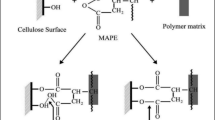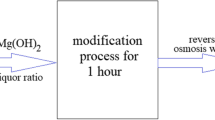Abstract
The increasing worldwide waste of polymers and agricultural products has prompted a pressing need for biodegradable plastic to help protect the environment. Hence, this research focuses on polybutylene adipate-co-terephthalate (PBAT) biodegradable polymers containing between 30–50 percent of filler to achieve an optimal balance of mechanical properties and biodegradation. Given its high lignin content, rice husk (RH) has displayed comparable properties to those of commercial lignin, and thus, the lignin from the rice husk was modified with acrylic acid grafting to facilitate the composite fabrication process. Fourier transform infrared (FTIR) analysis was used to demonstrate the grafting synergy and verify that the lignin/rice husk had been successfully grafted with the acrylic acid grafting process. Subsequently, the acrylic acid grafted lignin/rice husk was incorporated into PBAT to create a PBAT composite containing 30–50% AA lignin. The results revealed that the lignin: PBAT ratio at 30:70 (P70L30) resulted in the most optimum mechanical properties and biodegradability. These included tensile strength of 19.48 MPa, elongation at break of 20.26 MPa, Young’s modulus of 1913.62%, and crystallinity of 31.45%. The biodegradation of P70L30 was 57.36% over the 6 months, which was faster than the 9.2% degradation of PBAT. Additionally, the water absorption of P70L30 was two times more compared to PBAT, indicating the change in hydrophobicity of PBAT to a hydrophilic composite. Agricultural waste-rice husk displayed identical properties to lignin when incorporated into PBAT and resulting in the mechanical properties of strength, elongation at yield, and Young’s modulus of 19.09 MPa, 21.87%, and 1936.98 MPa. The mechanical properties and biodegradability of P70L30 on both lignin/rice husk in PBAT composite demonstrated the potential of affordable materials to create sustainable packaging solutions with good biodegradability and added features.








Similar content being viewed by others
Data Availability
The data presented in this study are available on request from the corresponding author.
References
United States Environmental Protection Agency (2018) EPA. In: United States Environ. Prot. Agency. https://www.epa.gov/sites/default/files/2021-01/documents/2018_ff_fact_sheet_dec_2020_fnl_508.pdf
Eurostat (2021) Waste statistics in the European Union. https://ec.europa.eu/eurostat/statistics-explained/index.php?title=Packaging_waste_statistics
Geyer R, Jambeck JR, Law KL (2017) Production, use, and fate of all plastics ever made. Sci Adv 3:25–29. https://doi.org/10.1126/sciadv.1700782
Ilyas RA, Sapuan SM, Kadier A et al (2020) Properties and Characterization of PLA, PHA, and Other Types of Biopolymer Composites. Elsevier Inc
World Bank (2012) Solid Waste Management in the World’s Cities. World Bank, Washington, DC
Antić-Mladenović S, Frohne T, Kresović M et al (2017) Biogeochemistry of Ni and Pb in a periodically flooded arable soil: Fractionation and redox-induced (im)mobilization. J Environ Manage 186:141–150. https://doi.org/10.1016/j.jenvman.2016.06.005
Heidarzadeh N, Rafizadeh M, Taromi FA et al (2017) Biodegradability and biocompatibility of copoly(butylene sebacate-co-terephthalate)s. Polym Degrad Stab 135:18–30. https://doi.org/10.1016/j.polymdegradstab.2016.11.013
Benavides PT, Lee U, Zarè-Mehrjerdi O (2020) Life cycle greenhouse gas emissions and energy use of polylactic acid, bio-derived polyethylene, and fossil-derived polyethylene. J Clean Prod 277:. https://doi.org/10.1016/j.jclepro.2020.124010
Jian J, Xiangbin Z, Xianbo H (2020) An overview on synthesis, properties and applications of poly(butylene-adipate-co-terephthalate)–PBAT. Adv Ind Eng Polym Res 3:19–26. https://doi.org/10.1016/j.aiepr.2020.01.001
Dammak M, Fourati Y, Tarrés Q et al (2020) Blends of PBAT with plasticized starch for packaging applications: Mechanical properties, rheological behaviour and biodegradability. Ind Crops Prod 144:. https://doi.org/10.1016/j.indcrop.2019.112061
Havstad MR, Juroš L, Katančić Z, Pilipović A (2021) Influence of home composting on tensile properties of commercial biodegradable plastic films. Polymers (Basel) 13:. https://doi.org/10.3390/polym13162785
Kanwal A (2021) Polymer pollution and its solutions with special emphasis on Poly (butylene adipate terephthalate (PBAT)). Polym Bull. https://doi.org/10.1007/s00289-021-04065-2
Agrawal R, Kumar A, Singh S, Sharma K (2022) Recent advances and future perspectives of lignin biopolymers. J Polym Res 29:222. https://doi.org/10.1007/s10965-022-03068-5
Yang S, Yuan TQ, Shi Q, Sun RC (2018) Application of lignin in thermoplastic materials. J Encycl Sustain Sci Technol 1–22
Liu Y, Liu S, Liu Z et al (2021) Enhanced mechanical and biodegradable properties of PBAT/lignin composites via silane grafting and reactive extrusion. Compos Part B Eng 220:108980. https://doi.org/10.1016/j.compositesb.2021.108980
Xiong SJ, Pang B, Zhou SJ et al (2020) Economically Competitive Biodegradable PBAT/Lignin Composites: Effect of Lignin Methylation and Compatibilizer. ACS Sustain Chem Eng 8:5338–5346. https://doi.org/10.1021/acssuschemeng.0c00789
Yang Y, Zhang C, Weng Y (2021) Effects of CaCO3 surface modification and water spraying on the weathering properties of PBAT/CaCO3 films. Polym Test 102:. https://doi.org/10.1016/j.polymertesting.2021.107334
Hossain SKS, Mathur L, Roy PK (2018) Rice husk/rice husk ash as an alternative source of silica in ceramics: A review. J Asian Ceram Soc 6:299–313. https://doi.org/10.1080/21870764.2018.1539210
Nguyen NT, Tran NT, Phan TP et al (2022) The extraction of lignocelluloses and silica from rice husk using a single biorefinery process and their characteristics. J Ind Eng Chem 108:150–158. https://doi.org/10.1016/j.jiec.2021.12.032
Figueiredo P, Lintinen K, Hirvonen JT et al (2018) Properties and chemical modifications of lignin: Towards lignin-based nanomaterials for biomedical applications. Prog Mater Sci 93:233–269. https://doi.org/10.1016/j.pmatsci.2017.12.001
Joutey NT, Bahafid W, Sayel H, El Ghachtouli N (2013) Biodegradation: Involved Microorganisms and Genetically Engineered Microorganisms
Muthusamy Subramanian AV, Thanigachalam M (2022) Mechanical performances, in-vitro antibacterial study and bone stress prediction of ceramic particulates filled polyether ether ketone nanocomposites for medical applications. J Polym Res 29:318. https://doi.org/10.1007/s10965-022-03180-6
Ibrahim MNM, Iqbal A, Shen CC et al (2019) Synthesis of lignin based composites of TiO2 for potential application as radical scavengers in sunscreen formulation. BMC Chem 13:1–15. https://doi.org/10.1186/s13065-019-0537-3
Kubovský I, Kačíková D, Kačík F (2020) Structural changes of oak wood main components caused by thermal modification. Polymers (Basel) 12:. https://doi.org/10.3390/polym12020485
Porkodi P, A JK, Sunil S et al (2021) Lignin addition to polyacrylonitrile copolymer solution and its effect on the properties of carbon fiber precursor. J Polym Res 28:54. https://doi.org/10.1007/s10965-021-02420-5
Cichosz S, Masek A (2020) IR study on cellulose with the varied moisture contents: Insight into the supramolecular structure. Materials (Basel) 13:1–22. https://doi.org/10.3390/ma13204573
Ryu SR, Noda I, Jung YM (2011) Positional Fluctuation of IR Absorption Peaks: Frequency Shift of a Single Band or Relative Intensity Changes of Overlapped Bands? Am Lab
Podkos̈cielna B, Sobiesiak M, Zhao Y et al (2015) Preparation of lignin-containing porous microspheres through the copolymerization of lignin acrylate derivatives with styrene and divinylbenzene. Holzforschung 69:769–776. https://doi.org/10.1515/hf-2014-0265
Martín JA, Solla A, Woodward S, Gil L (2005) Fourier transform-infrared spectroscopy as a new method for evaluating host resistance in the Dutch elm disease complex. Tree Physiol 25:1331–1338. https://doi.org/10.1093/treephys/25.10.1331
Adam F, Appaturi JN, Thankappan R, Nawi MAM (2010) Silica-tin nanotubes prepared from rice husk ash by sol-gel method: Characterization and its photocatalytic activity. Appl Surf Sci 257:811–816. https://doi.org/10.1016/j.apsusc.2010.07.070
Abderrahim B, Abderrahman E, Mohamed A et al (2015) Kinetic Thermal Degradation of Cellulose, Polybutylene Succinate and a Green Composite: Comparative Study. World J Environ Eng Vol 3, 2015, Pages 95–110 3:95–110. https://doi.org/10.12691/WJEE-3-4-1
Ma’Ruf A, Pramudono B, Aryanti N (2017) Lignin isolation process from rice husk by alkaline hydrogen peroxide: Lignin and silica extracted. AIP Conf Proc 1823:. https://doi.org/10.1063/1.4978086
Appaturi JN, Adam F, Khanam Z (2012) A comparative study of the regioselective ring opening of styrene oxide with aniline over several types of mesoporous silica materials. Microporous Mesoporous Mater 156:16–21. https://doi.org/10.1016/j.micromeso.2012.01.023
Azmi MA, Ismail NAA, Rizamarhaiza M et al (2016) Characterisation of silica derived from rice husk (Muar, Johor, Malaysia) decomposition at different temperatures. AIP Conf Proc 1756:. https://doi.org/10.1063/1.4958748
Chen RS, Salleh MN, Ghani MHA et al (2015) Biocomposites Based on Rice Husk Flour and Recycled Polymer Blend: Effects of Interfacial Modification and High Fibre Loading. BioResources 10:6872–6885. https://doi.org/10.15376/biores.10.4.6872-6885
da Silva JBA, Santana JS, de Almeida Lucas A et al (2019) PBAT/TPS-nanowhiskers blends preparation and application as food packaging. J Appl Polym Sci 136:. https://doi.org/10.1002/app.47699
Ming M, Zhou Y, Wang L et al (2022) Effect of polycarbodiimide on the structure and mechanical properties of PLA/PBAT blends. J Polym Res 29:371. https://doi.org/10.1007/s10965-022-03227-8
Yap SY, Sreekantan S, Hassan M et al (2020) Characterization and Biodegradability of Rice Husk-Filled Polymer Composites. Polymers (Basel) 13:104. https://doi.org/10.3390/polym13010104
Yi T, Qi M, Mo Q et al (2020) Ecofriendly preparation and characterization of a cassava starch/polybutylene adipate terephthalate film. Processes 8:. https://doi.org/10.3390/pr8030329
Kang SM, Ahn JY, Kim YB, Choi DK (2004) Influence of the Electric Field on the Ni-Lnduced Low-Temperature Crystallization of Amorphous Silicon Films. J Korean Phys Soc 44:177–180
Chemtec Publishing (2016) EFFECT OF NUCLEATING AGENTS ON PHYSICAL-MECHANICAL PROPERTIES. Handb Nucleating Agents
Klapiszewski Ł, Grząbka-Zasadzińska A, Borysiak S, Jesionowski T (2019) Preparation and characterization of polypropylene composites reinforced by functional ZnO/lignin hybrid materials. Polym Test 79:. https://doi.org/10.1016/j.polymertesting.2019.106058
Jakob M, Mahendran AR, Gindl-Altmutter W, Bliem P, Konnerth J, Mueller U, Veigel S (2021) The strength and stiffness of oriented wood and cellulose-fibre materials: A review. Prog Mater Sci. https://doi.org/10.1016/j.pmatsci.2021.100916
Wei B, Zhao Y, Wei Y et al (2019) Morphology and Properties of a New Biodegradable Material Prepared from Zein and Poly(butylene adipate-terephthalate) by Reactive Blending. ACS Omega 4:5609–5616. https://doi.org/10.1021/acsomega.9b00210
Alipoormazandarani N, Fatehi P (2020) Lignin-methyl methacrylate polymer as a hydrophobic multifunctional material. Ind Crops Prod 154:112728. https://doi.org/10.1016/j.indcrop.2020.112728
Roychowdhury T, Cushman CV, Major G, Linford MR (2015) The Surface Analytical Chemistry (XPS) and Polymer Chemistry of the Acrylates and Methacrylates, an Introduction. Vac Technol Coat
Zhou H, Liu W, Zhang B, Xue Y, Tang Z (2022) Regulation of hydrophilic performance for chlorinated polyethylene grafting acrylic acid via co-irradiation. Mater Lett. https://doi.org/10.1016/j.matlet.2021.131576
Rassiah K, Sin TW, Ismail MZ (2016) A study on flexural and water absorption of surface modified rice husk flour/E-glass/polypropylene hybrid composite. IOP Conf Ser Mater Sci Eng 152:. https://doi.org/10.1088/1757-899X/152/1/012061
Yang B, Nagarajan B, Mertiny P (2021) Characterization of swelling behavior of carbon nano-filler modified polydimethylsiloxane composites. J Elastomers Plast 53:955–974. https://doi.org/10.1177/00952443211006156
Ballantine DS Jr, Martin SJ, Ricco AJ,Frye GC, Wohltjen H, White RM, Zellers ET (1997) Chapter 4 - Materials Characterization. In: Acoustic Wave Sensors: Theory, Design and Physico-Chemical Applications. pp 150–221
Skleničková K, Abbrent S, Halecký M et al (2022) Biodegradability and ecotoxicity of polyurethane foams: A review. Crit Rev Environ Sci Technol 52:157–202. https://doi.org/10.1080/10643389.2020.1818496
Fukushima K, Rasyida A, Yang MC (2013) Biocompatibility of organically modified nanocomposites based on PBAT. J Polym Res 20:. https://doi.org/10.1007/s10965-013-0302-6
Acknowledgements
The authors thank the Ministry of Higher Education for providing the Fundamental Research Grant Scheme (FRGS) (FRGS/1/2021/TK0/USM/01/1). The authors thank Universiti Sains Malaysia (USM) for providing the necessary facilities for this research work.
Author information
Authors and Affiliations
Corresponding author
Ethics declarations
Ethical approval
This article does not contain any studies with human participants or animals performed by any of the authors.
Informed consent
Informed consent was not obtained as no human participants were involved in this study.
Conflict of interest
Hong Han Choo, Srimala Sreekantan and Jimmy Nelson Appaturi declare that they have no conflict of interest.
Additional information
Publisher's Note
Springer Nature remains neutral with regard to jurisdictional claims in published maps and institutional affiliations.
Rights and permissions
Springer Nature or its licensor (e.g. a society or other partner) holds exclusive rights to this article under a publishing agreement with the author(s) or other rightsholder(s); author self-archiving of the accepted manuscript version of this article is solely governed by the terms of such publishing agreement and applicable law.
About this article
Cite this article
Choo, H.H., Sreekantan, S. & Appaturi, J.N. Preparation, characterization and biodegradability of acrylate graft rice husk/ lignin reinforced PBAT. J Polym Res 30, 377 (2023). https://doi.org/10.1007/s10965-023-03760-0
Received:
Accepted:
Published:
DOI: https://doi.org/10.1007/s10965-023-03760-0




